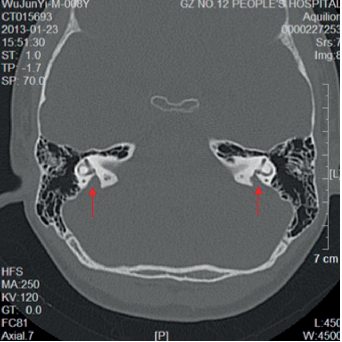Abstract
OBJECTIVES: To explore the characteristics of variations in patients with nonsyndromic hearing impairment (NSHI) in Southern China to supply a theoretical basis for screening, intervention, and prevention.
MATERIALS and METHODS: A total of 634 hearing-impaired students from the special schools for the deaf and 220 normal-hearing individuals in South China were tested using an allele-specific polymerase chain reaction-based universal array, and the screened SLC26A4 mutation carrier was examined using computed tomography. The pathogenesis of deafness was analyzed using pathography and objective hearing tests.
RESULTS: In total, 151 patients with NSHI carried pathogenic mutations in the screening chip, and the carrier rate was 23.82% (151/634) in the studied population. Of the 151 screened carriers, 65 (10.25%) patients harbored homozygous or homoplasmy mutated genes associated with autosomal recessive hearing loss; 36 (5.68%) patients with mutant alleles were homozygous for the GJB2 c.235delC mutation and 27 (4.26%) were heterozygous. Furthermore, 18 (2.84%) patients were homozygous with mutant alleles for the SLC26A4 c.919-2A>G mutation and 43 (6.78%) were heterozygous; 7 (1.10%) patients were homoplasmy mutation carriers of MT-RNR1 gene. There was 1 SLC26A4 c.919-2A>G and 1 GJB2 c.235delC heterozygous mutant allele in the group of 220 normal-hearing individuals.
CONCLUSION: GJB2 and SLC26A4 were much more prevalent than MT-RNR1 and GJB3 in South China according to this gene chip. Minuscule differences in the mutation spectrum or prevalence of GJB2 c.235delC and SLC26A4 c.919-2A>G were found in our study; furthermore, a relatively high incidence of variations was observed among these individuals with NSHI.
Cite this article as: Lin Y, Yu F, Jiao Y, Zhou F. Variations in the Mutational Spectrum in Nonsyndromic Hearing Impairment: A Study of the Special Schools For the Deaf in Southern China. J Int Adv Otol 2019; 15(2): 247-52.


.jpg)
.png)
.png)
